We often think of herb gardens as sunny little patches outside the kitchen window, and many common herbs are grown in full sun. But there are plenty of herbs – some common and some not so common- that will grow wonderfully in the shade.
If you want delightful and shade-tolerant herbs but don’t have much direct sun, try planting some of these 31 herbs that grow in the shade.
| Mint, mentha | Chives, Allium schoenoprasum |
| Parsley, Petroselinum crispum | Cliantro, Coriandrum sativum |
| Tarragon, artemisia dracunculus | Golden Oregano, Origanum vulgare ‘Aureum’ |
| Wild Bergamot, Monarda fistulosa L. | Lemon Balm, Melissa officinalis |
| Thyme, Thymus vulgaris | Sweet Woodruff, Galium odoratum |
| Angelica, Angelica archangelica | Anise, pimpinella anisum |
| Meadowsweet, Filipendula ulmaria | Red perilla, perilla frutescens |
| Spice bush, Lindera benzoin | Borage, Borago officinalis |
| Chervil, Anthriscus cerefolium | Stinging nettle, Urtica dioica |
| Corsican mint, Mentha requienii | Bigroot geranium, Geranium macrorrhizum |
| Lovage, Levisticum officinale | Sorrel, Rumex acetosa |
| Sweet Grass, Hierochloe odorata | Basil, Ocimum basilicum |
| Bay Laurel, Laurus nobilis | Garlic Chive, Allium tuberosum |
| Ginseng, Panax ginseng, P. notoginseng, P. quinquefolius, etc. | Cutting Celery, Apium graveolens |
| Sweet cicely, Myrrhis odorata | Wild ginger, Asarum canadense L. |
| Roman Chamomile, Chamaemelum nobile |
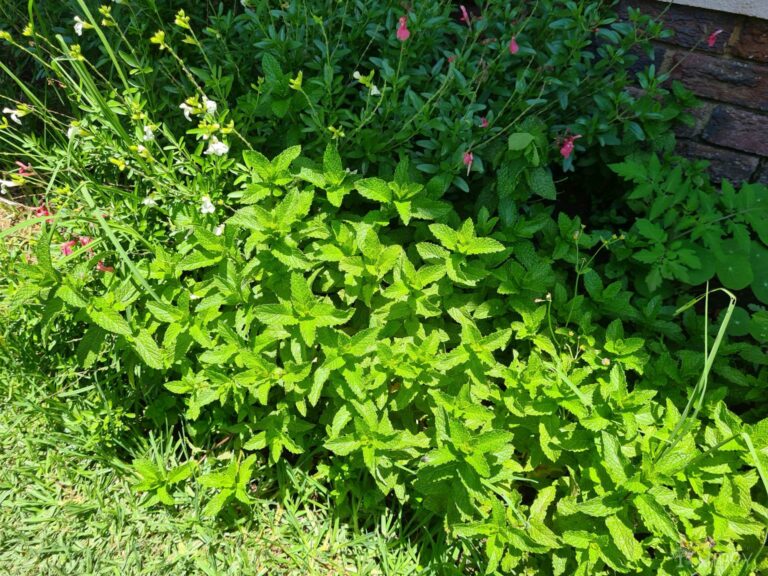
1) Mint, mentha
There are many varieties of mint, among them spearmint and apple mint, but they all share that particularly obvious minty fragrance we love. Mint will tolerate some shade, however, the variegated varieties of mint need to be protected from full sun.
If you are looking to grow mint in the shade, choose one of those variegated varieties for this reason. Be aware that mint can get leggy when it is grown in the shade, so you may need to prune it often. Just pinch back the tops, or cut off what you need.
Mint is great for use in tea, drinks, and salads. It is thought to ease digestion and increase concentration. You can read more about growing mint here.

2) Chives, Allium schoenoprasum
Don’t overlook growing some delicious chives in your shady herb garden. Although chives prefer full sun, they will also grow just fine in the shade. Chives are hardy little perennials, and will grow in almost any kind of soil, garden, or container.
They are drought and cold tolerate, as well, and require very little care to thrive. You can trim them continuously and they will keep growing.
Chives are great toppers for baked potatoes, chili, and salads, but they can be used in many other ways as well. The purple blooms are edible and taste a bit like mild onions.
You can use the blossoms to garnish dishes, or pull apart the florets and sprinkle them on salads to add flavor and color.
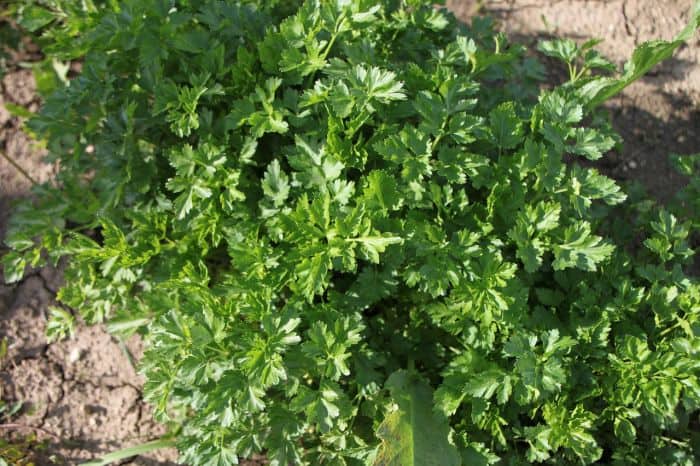
3) Parsley, Petroselinum crispum
This herb is a famous plate garnish and breath freshener, but it is also a common ingredient for soups, sauces, and vegetable dishes. The roots of parsley plants can be chopped and cooked in soups or stews.
This pretty little herb is a member of the carrot family. It can be grown in full sun and part shade, but this biennial does not like high humidity. In hot and humid areas, your parsley may actually do better in the cool of the shade than in the hot sun.
Parsley grows best in rich, well-draining soil. The soil should be kept moist during the growing season to encourage growth and keep it cool. It is sensitive to freezing cold, and can be brought indoors for the winter or replanted the following spring.

4) Cliantro, Coriandrum sativum
Cilantro is an interesting herb. The plant as a whole, and especially the seeds, is typically known as coriander, but when the leaves are eaten separately they are known as cilantro. The seeds and leaves have surprisingly different flavors.
Cilantro is great in stir-fry, pasta salad, salad dressings, and the like. You can use both the stems and leaves. Coriander is popular for pickles and soups and pairs well with carrots and cumin.
Cilantro does not like harsh, hot sun, and will grow well in the cool of the shade. Keep the soil moist during the growing season. Because cilantro bolts quickly, you will want to succession plant it throughout the summer.
Once it bolts, wait for the seeds to form. You can dry the seeds in a paper bag and use them whole or ground.
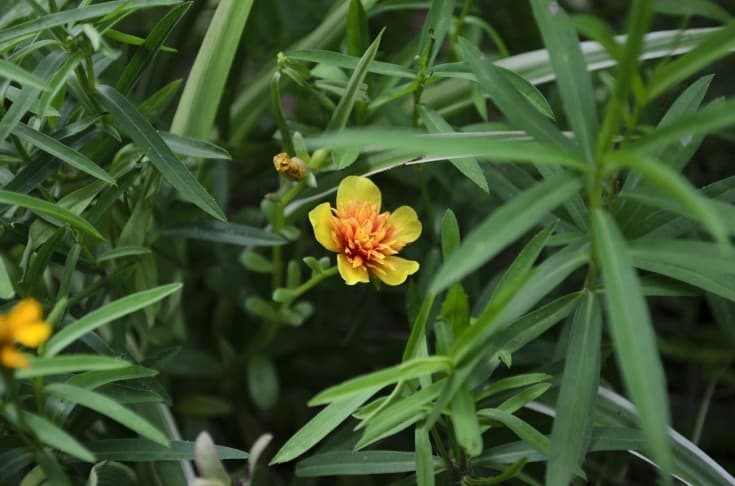
5) Tarragon, artemisia dracunculus
Tarragon has a flavor similar to licorice or anise, with a bit of a peppery taste. French tarragon is more flavorful and less coarse than Russian tarragon, so generally French tarragon is chosen for culinary purposes.
It pairs well with tomatoes and carrots, and makes a delightful flavoring for vinegar. Use tarragon sparingly, as the flavor is strong and it can easily overpower a dish.
Tarragon is a member of the sunflower family. It likes growing in the morning sun, but definitely prefers shade in the afternoons.
Plant it in soil that has been amended with compost or worm castings. Tarragon will die back in the winter but is one of the first herbs to emerge again in the spring.
6) Golden Oregano, Origanum vulgare ‘Aureum’
Golden oregano grows bright yellow to golden foliage with pink and purple blooms. It loves part sun to full shade, and will grow well in containers with well-draining soil.
This beautiful plant makes an attractive little shrub that is low maintenance, drought tolerant, and easy to grow. Grow it in your kitchen garden or as a decorative plant in your flower beds.
Use golden oregano in cooking just like you would any other fresh oregano. It is a staple flavoring in both pizza and tomato sauces. You can chop the leaves finely, eat the blossoms, and dry the herb in small bunches.
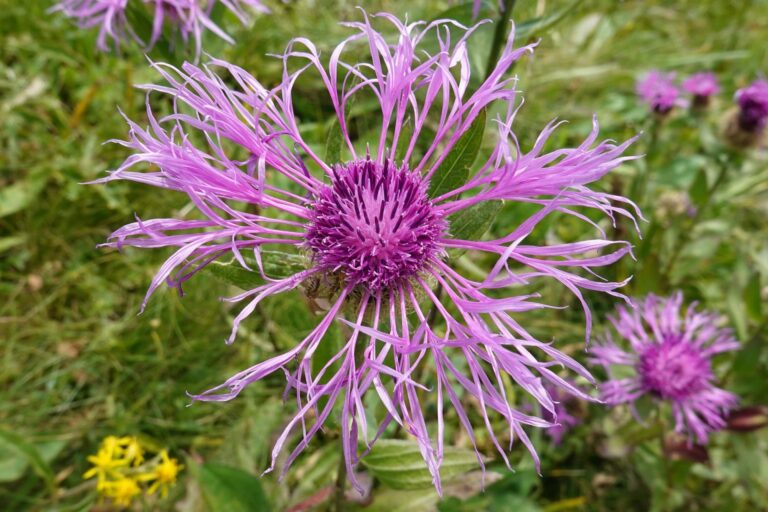
7) Wild Bergamot, Monarda fistulosa L.
Wild bergamot, also known as bee balm, is used in teas, tinctures, and salads. This attractive herb bears beautiful flowers and is a member of the mint family.
The leaves, flowers, and stems are edible on this pretty plant. The flowers attract pollinators, hummingbirds, and butterflies to the garden.
Wild Bergamot can grow in almost any type of soil as long it as drains well. It is hardy and drought tolerant.
Although it can grow well in the shade, it will not flower as much when it does not receive direct sunlight.
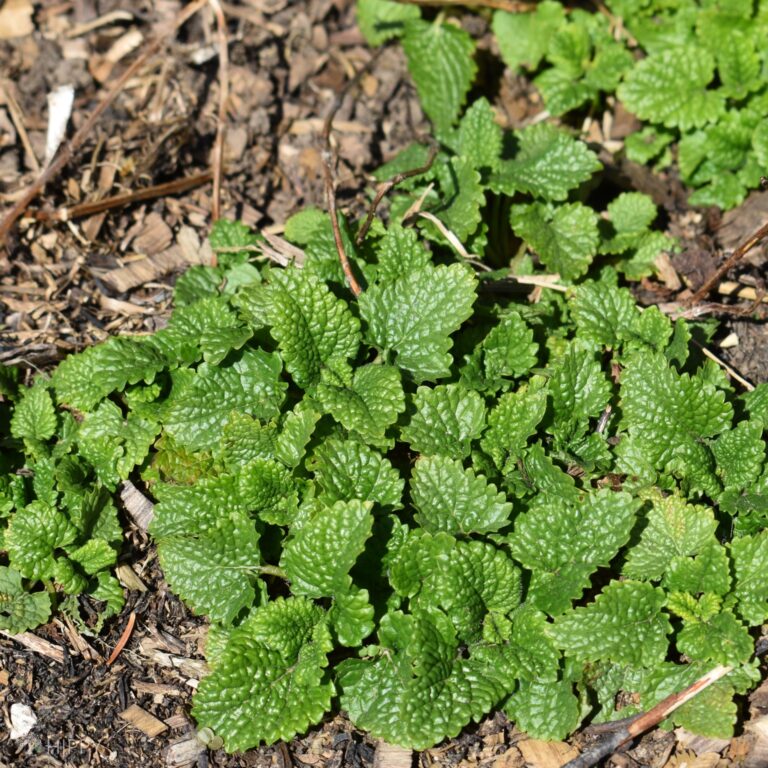
8) Lemon Balm, Melissa officinalis
Lemon balm is another fragrant herb that is related to the mint family. This herb is a hardy perennial, which is hard to contain once it gets established in your garden or yard.
The lemon-scented, minty leaves work great in hot and cold teas, and add a tart flavor to salads and meats.
Lemon balm will grow well in the shade but will need to be trimmed frequently so it doesn’t get leggy. On the bright side, lemon balm will be less likely to bolt in the shade. Bolting reduces the flavor and aroma of this herb. Plant lemon balm in rich, well-draining soil.
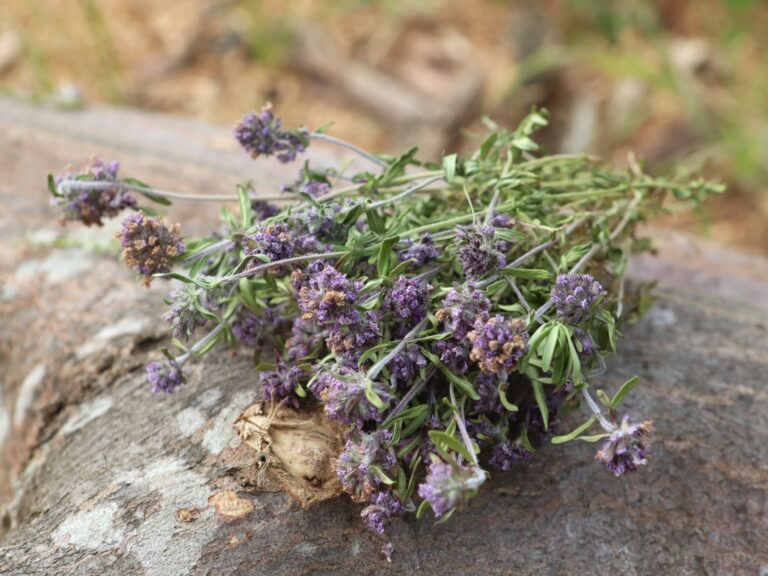
9) Thyme, Thymus vulgaris
This delightful little herb is often used to season protein dishes and vegetables and rarely causes allergic reactions.
Common thyme and lemon thyme are the most common varieties used for cooking. Both varieties have a grassy, floral flavor, but lemon thyme has strong citrus notes as well. To cook with thyme, you can use just the leaves or the entire stem with leaves attached.
This sweet little herb grows best in dappled sunshine in a dry area. It will tolerate shade, but it probably won’t bloom unless it gets a little sun. It can be grown in crevices, borders, herb gardens, and even in a sunny window in your kitchen.
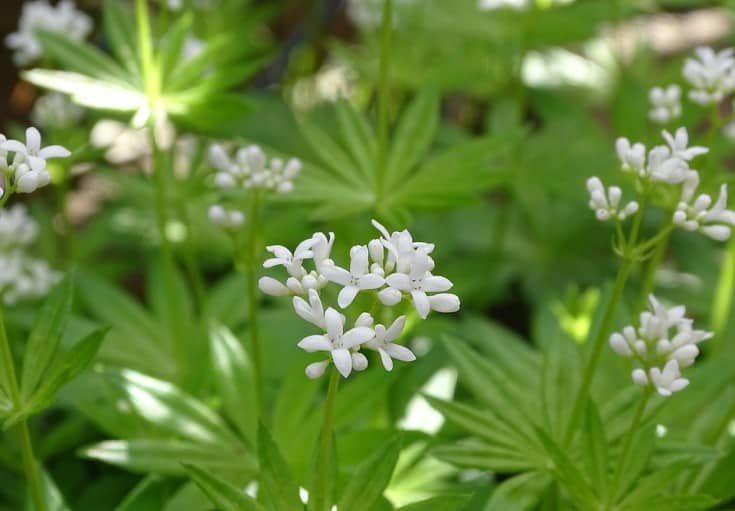
10) Sweet Woodruff, Galium odoratum
Sweet Woodruff is a low-growing, fast-spreading perennial with a vanilla scent. It grows in small spirals of glossy green leaves topped with pretty little white flowers. Dried, it can be used for potpourri and sachets because its fragrance is long-lasting.
It is often used to flavor wines and teas and can be used in jellies and salads. Sweet Woodruff loves the shade and will thrive in moist areas. It can be seen as an invasive plant however it makes a wonderful ground cover in shady areas.
This hardy herb can take almost a year to germinate from seed, but the plant will grow prolifically by sending out runners.
11) Angelica, Angelica archangelica
This fragrant biennial/perennial grows best under woodland conditions with rich soil and dappled sunshine. It does not tolerate high heat well. It can grow four to six feet tall with umbrella-like white flowers.
After going to seed, the plant will die. You can prolong the life of your angelica plants by cutting back the flower heads before they go to seed.
The leaves can be blanched, boiled, or used in salads. Seeds have a bitter flavor and have been used in cakes, candies, and spirits.
Dried roots have been used to make medicine, but fresh roots are typically described as poisonous and inedible.
12) Anise, pimpinella anisum
Anise grows white umbrella-like flowers with feathery leaves on plants that are one and a half to three feet tall. Its seed can be used whole or ground.
It has a sweet and spicy licorice flavor and is often used in doughs, breads, meats, and pie fillings. The seeds can be made into an extract which is used to flavor coffee drinks and hot chocolate.
Anise does not transplant well so it is better to direct sow this plant either in containers or in your garden. This plant needs wind protection but will thrive in poor soil with light shade.
13) Meadowsweet, Filipendula ulmaria
This edible perennial is typically used for its medicinal purposes, although in the spring, the young greens can be eaten in salads or cooked in soups.
It grows three to six feet tall, with bunches of tall white flowers. The flowers contain salicylic acid and are known to attract many types of pollinators.
You can grow meadowsweet in part shade as long as you have moist soil. Meadowsweet seeds need to be surface-sown so they have light to germinate. Gently press seeds into soil so they don’t get blown away. It takes as many as three months for meadowsweet seeds to germinate.
14) Red perilla, perilla frutescens
Shiso, or red perilla, is a member of the mint family with a somewhat unique flavor. This purple herb with toothy, heart-shaped leaves works great to flavor fruit dishes, teas, and to brighten up a drab salad.
Baby leaves of red perilla make a wonderful garnish. The red and purple varieties of perilla are used to add color to pickles.
Red perilla might be considered an invasive plant so be wary of where you plant yours. Although it is an annual that can be difficult to grow from seed, once you get a bed established it should reseed itself.
For this reason, it makes a great ground cover and color compliment to your flower beds. Grow red perilla in sun to part shade, in the garden, flower bed, or even in a pot.
15) Spice bush, Lindera benzoin
Spice bush, also known as wild allspice, or fever bush, is named for the crisp, spicy aroma it gives off. This large bush grows dark green leaves that turn yellow in the fall.
Tiny yellow flowers turn into beauty red berries in the fall. The berries can be dried and ground to use like allspice, while the bark makes a nice substitute for cinnamon.
This bush will grow well in damp soil and partial shade. It can be pruned for size and shape. In order to get berries, you will need both a male and female bush. Berries only grow on female spice bushes and must have a male nearby to fertilize them.

16) Borage, Borago officinalis
Borage, or bee bush, is a medicinal herb with edible leaves and flowers. It has a taste similar to cucumber, and can be used as salad greens, garnishes, in jellies, teas, soups, and cocktails.
This annual easily reseeds itself, so once you have an established bed, it should continue to regrow year after year. Not only does it attract bees to your garden, it also repels hornworms and other pests.
Borage will grow just fine in partial shade but growing it in full sun will give you the most blooms. Direct seed borage in any type of soil but amending the soil with compost will give your plants a nice boost.
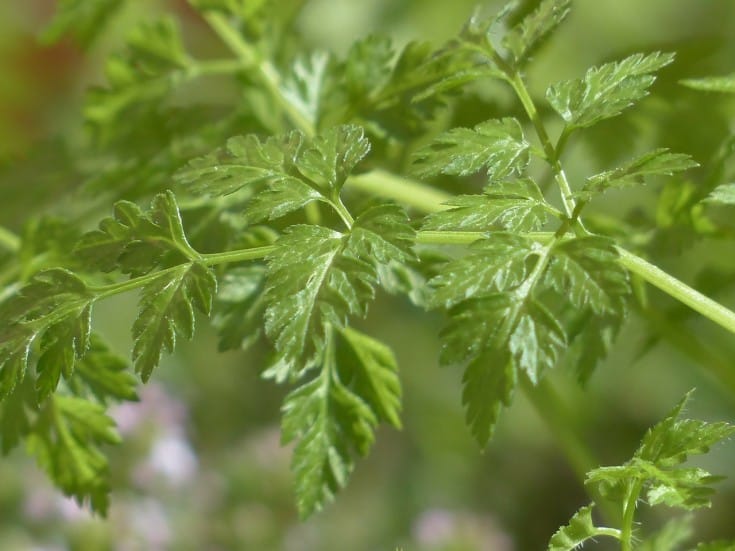
17) Chervil, Anthriscus cerefolium
Chervil, sometimes called French Parsely, has a mild flavor related to parsley with hints of anise. This delicate herb is often used in French cuisine. Chervil tastes great in omelets, egg dishes, salads, infused oils and butters.
Chervil has delicate, frilly leaves that resemble carrot greens. You can grow this herb in full sun, partial shade, and even indoors. It has a tendency to become leggy, so keep these plants well-pruned to help them maintain a more bushy, compact shape.
You can direct sow chervil right in your garden into amended soil. Keep it well-watered, especially during the heat of summer. Chervil will grow more foliage in cooler weather.
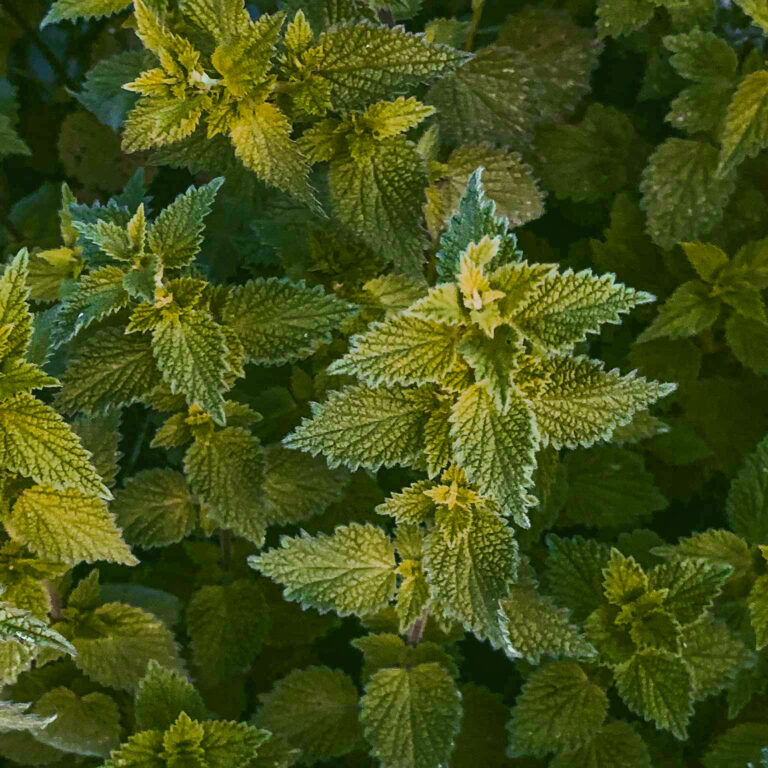
18) Stinging nettle, Urtica dioica
Nettles are a highly nutritious plant known for their painful sting. When brushed up against, stinging nettles release a compound into the skin which causes a histamine and serotonin reaction, inducing painful hives, swelling, and rash.
However, cooking removes this threat, and the tender young plant can be boiled, steamed, and dried.
Stinging nettles will grow just fine in part shade to full sun, especially with a rich, moist, loamy soil. These plants are considered highly invasive and well spread rapidly when conditions are just right.
Avoid planting stinging nettles where they will come in contact with pets or small children. Always wear gloves when harvesting and be sure to properly prepare them before eating.
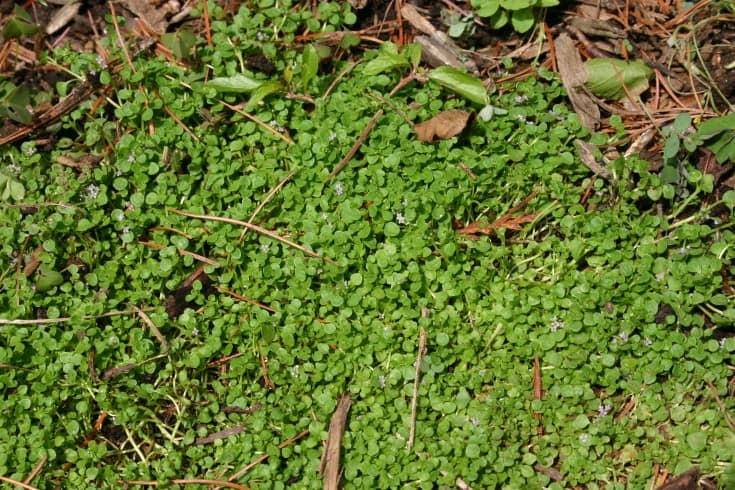
19) Corsican mint, Mentha requienii
This species of mint with its peppermint flavor is a small, ground-hugging plant used for Crème de Menthe, flavoring for hot or cold drinks, and even baked goods.
This creeping mint can spread aggressively and will fill in spaces between pavers as long as it doesn’t get heavy foot traffic.
You can grow Corsican mint in full sun or part shade, but it needs to be protected from intense sunlight either way. It is not very drought tolerant and will freeze in cold winters.
However, this dainty mint variety self-seeds easily through its tiny, purple flowers and will likely make a comeback on its own, even in cold climates. You can easily grow Corsican mint indoors in a sunny window.
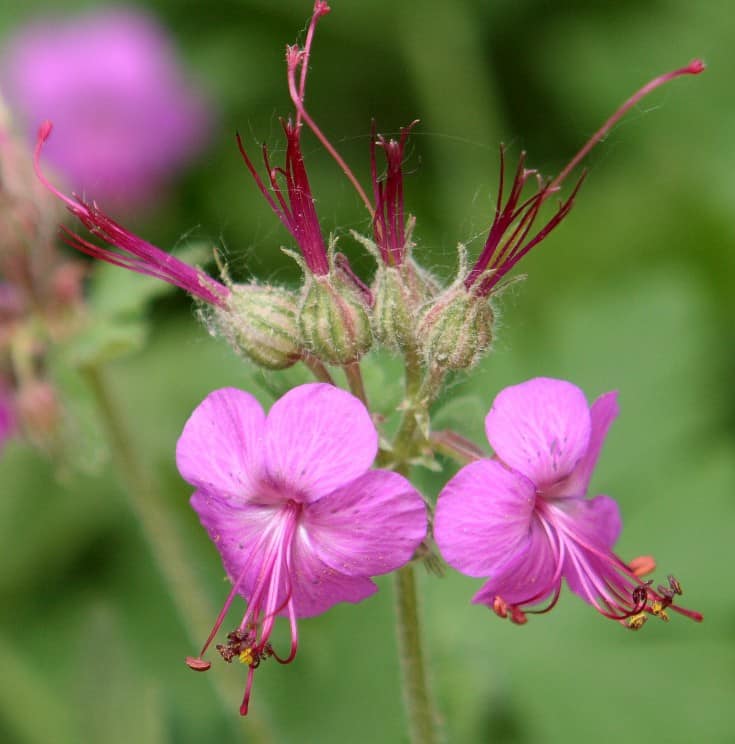
20) Bigroot geranium, Geranium macrorrhizum
This hardy perennial blooms early in the summertime. It is drought tolerant, grows well in average garden soil, and will thrive in part sun to part shade.
It makes a good ground cover because it spreads thickly through underground rhizomes. Geraniums can be used to flavor culinary dishes, in aromatherapy, and to ward off pests.
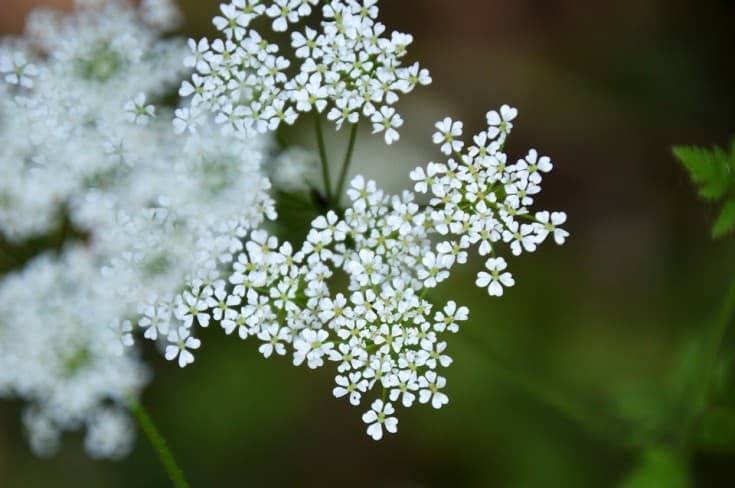
21) Sweet cicely, Myrrhis odorata
Sweet cicely is an edible, versatile perennial with lacy, fern-like leaves and sweet-smelling white flowers. It is often used in salads, the roots can be boiled and eaten as a vegetable, and the sweet leaves can be used as a substitute for sugar.
Raw leaves taste a little bit like anise, but the seeds can be ground and used as a spice. Sweet cicely seeds make a nice substitute for cloves.
This herb will thrive in full to part shade. It prefers moist, well-draining soil. You may want to direct sow your sweet cicely seeds, but they need a period of stratification before they will germinate.
For best results, sow seeds in the fall for a spring start or keep them in your refrigerator until you are ready to plant.
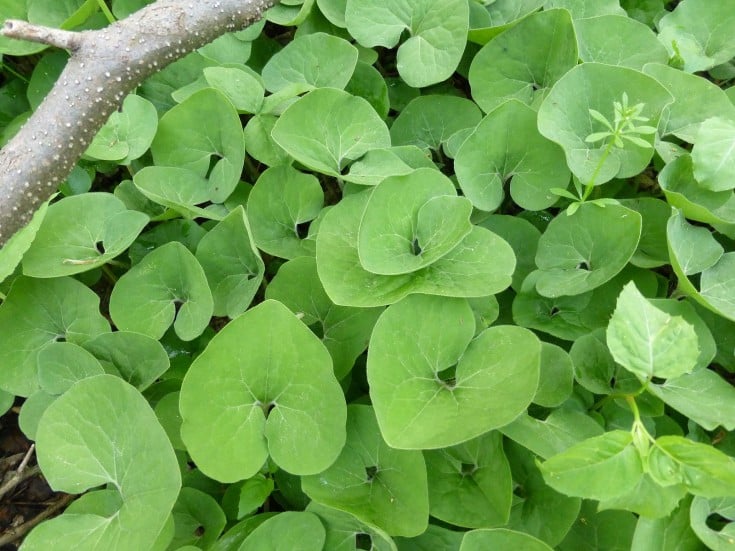
22) Wild ginger, Asarum canadense L.
This plant thrives in the shady forests of the Eastern United States. Low growing, upright heart-shaped leaves disguise the unique flowers at the base of the plant.
Wild ginger is often used as a substitute to the similarly named culinary ginger even though the two are unrelated. Scientific studies giving rats large quantities of AA, a compound found in wild ginger, showed high levels of toxicity to the rats.
Moderate ingestion, especially as a tea or flavoring, is unlikely to be problematic for people, but it is wise to be aware of the risks.
Wild ginger needs moist, well-draining soil with plenty of compost in full to partial shade. This plant will burn in direct sunlight.
Plants are most easily propagated via rhizome and splitting. Plants can be germinated from seed, although the germination process can take as long as two years.
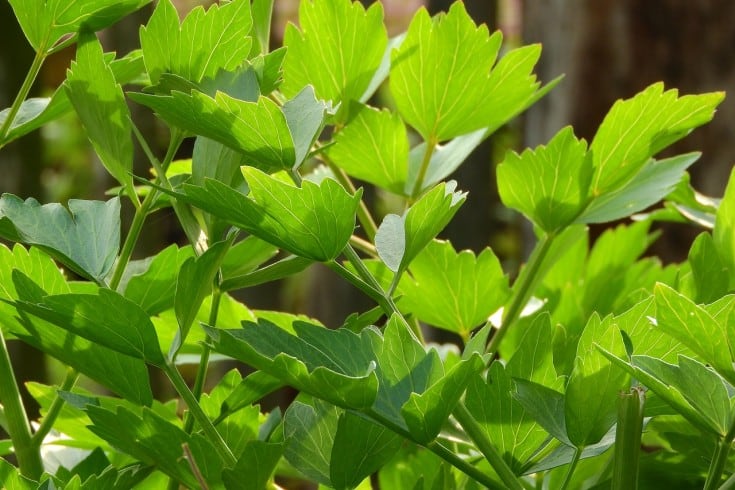
23) Lovage, Levisticum officinale
Sea parsley, or lovage, is a member of the parsley family. It has a flavor similar to celery and is used in all kinds of dishes such as poultry, pork, potatoes, and soups.
The seeds, leaves, and roots can all be eaten, although the peeling on the roots is bitter and can be removed.
This perennial can reach up to six feet high, although it will probably only grow to about two feet tall in its first year.
It does fine in partial shade with soil that is not dry. Lovage can be direct sown in areas that have a longer growing season.
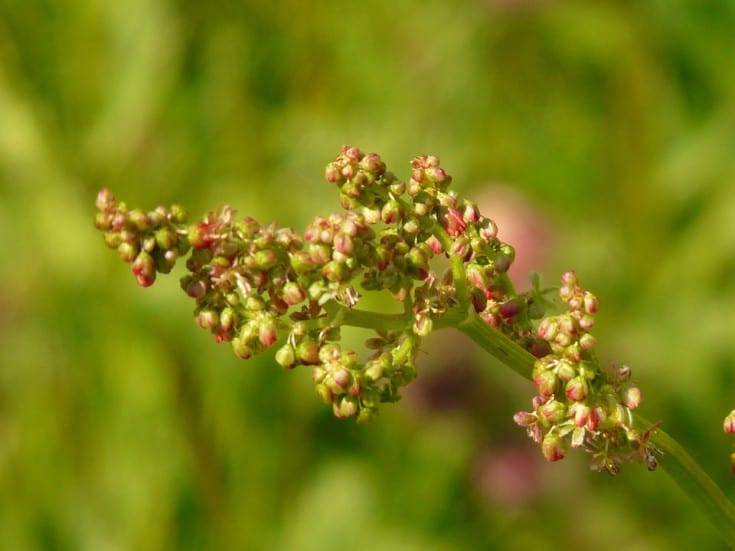
24) Sorrel, Rumex acetosa
Common sorrel or garden sorrel is a perennial herb often used in salads and kitchen gardens. It has a somewhat acidic, bitter flavor, and becomes more bitter as the season progresses.
Use smaller, more tender leaves as garnishes and in salads, and use larger more bitter leaves in cooked or steamed dishes such as pastas and soups.
Sorrel tastes better in early, cooler weather, and the heat encourages it to bolt quickly. You can grow sorrel in partial shade, with moist well-draining soil.
The shade will stave off bolting for at least awhile. Sorrel can grow up to six feet tall. It is very hardy and requires little maintenance.
25) Sweet Grass, Hierochloe odorata
Sweet grass, or Holy Grass, is a hardy perennial. It is used to make tea and flavor beverages, tobacco, and candy. It has a beautiful fragrance and is often used in perfumes and aromatherapy.
Flowers appear throughout the summer, and the plants grow berries in the late summer and early fall.
Holy Grass does not propagate well through its seeds, but it can become aggressive as it propagates quickly through rhizomes. It will grow well in partial shade and rich, moist soil.
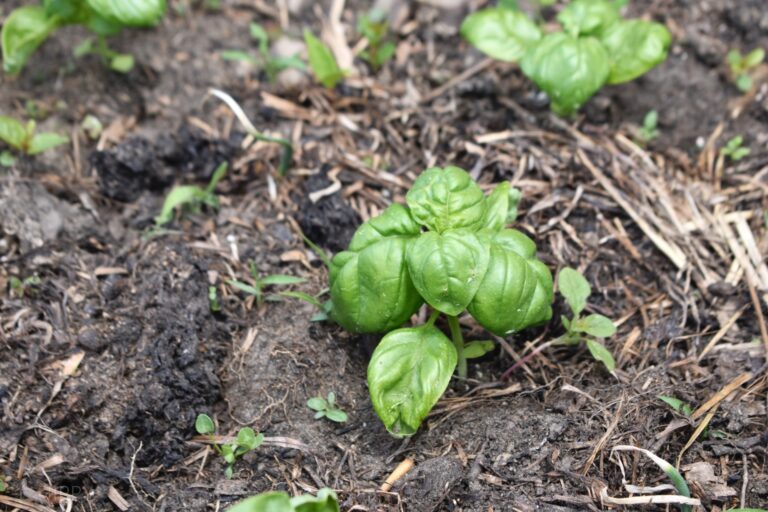
26) Basil, Ocimum basilicum
Beloved all over the world in various cuisines, many dishes are not complete without the addition of fresh basil leaves at the very end of cooking.
Grown as an annual in temperate climates, but as a perennial or even biennial and hotter regions, basil is tolerant of shade, particularly when all of its other needs are being met.
So long as you can protect it from frost and keep the soil well drained it will do well with even partial sun exposure.
Many gardeners keep their basil in pots so they can move it in or outside as necessary, but if you do bring it inside take care that you patch up any drafts when you keep it by a window as this can quickly stress the plant.
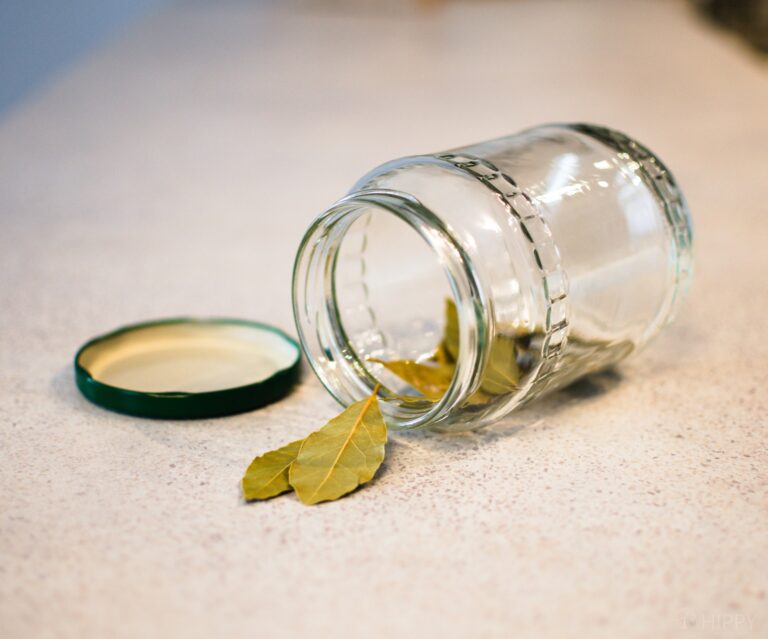
27) Bay Laurel, Laurus nobilis
Bay laurel, one of the many sources of bay leaves in the world, can provide you with an herb that lends soups, stews and other foods subtle and difficult to define flavor, but one that you’ll always know when it’s missing.
Remember, your bay leaves will not develop their full flavor until they are completely dried after picking.
It has also found favor as an ingredient in salves and poultices used for treating open wounds and rashes, a purpose that it has been called upon since ancient times.
Typically growing as an evergreen tree or shrub, these are plants that can tolerate almost anything except drought. Some shade definitely won’t hurt them,
28) Garlic Chive, Allium tuberosum
Garlic chives, also known as Chinese chives, are a relative to the usual chives we mentioned above. As long as they are watered regularly and kept moist in sandy, loam soil this herb is highly tolerant of full sun and partial shade alike.
A delicious addition to cultural cuisine throughout Asia, as you might guess by the name these jobs have a decidedly garlic taste compared to the more oniony taste of typical chives.
Once you harvest them, you can keep them in your refrigerator for a week or perhaps a little more so long as they’re in a moist bag or container.
You can also place chopped garlic chives in shallow containers in your freezer or dry them without risk of losing their flavor if you need to keep them longer.
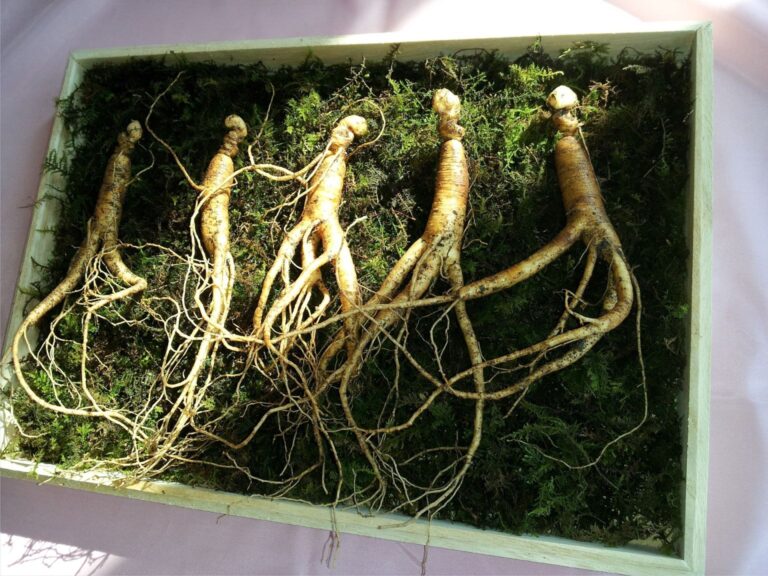
29) Ginseng, Panax ginseng, P. notoginseng, P. quinquefolius, etc.
Long regarded for its use as a medicinal herb, ginseng is one of the most shade loving herbs around and has been used for millennia in all sorts of traditional meds, a practice which continues today.
It is a regular staple in many over the counter supplements and as a tea or a tincture, ginseng is an excellent addition to your herbal medicine chest.
Although commonly associated with both Eastern cuisine and medicine, you might be surprised to learn that a species of ginseng, P. quinquefolius, is native to North America, where it grows in wooded areas on north- or east-facing slopes.
Ginseng loves cooler temps and shade, so that won’t be a problem if your garden or planters stay shady.
30) Cutting Celery, Apium graveolens
For our purposes, you can think of cutting celery as nothing more than a smaller cousin of garden celery.
Compared to its larger, more common relative you should find it highly shade tolerant and much easier to grow overall. But just like its larger cousin, it can be used as a seasoning in stews, soups and sauces.
Plant it late in spring after the last frost and you can harvest the leaves throughout the season, and so long as the plants are tended to you can depend on it as a reliable annual.
31) Roman Chamomile, Chamaemelum nobile
Tolerant of sun and partial shade alike, and even some foot traffic, this hardy herb does wonderfully when grown in zones 5 through 8. Roman chamomile is a variant of typical chamomile that is sometimes referred to as garden or English chamomile.
As a ground cover, this fragrant herb can replace grass so long as you keep the foot travel to a minimum.
Notably, Roman chamomile has almost totally replaced true chamomile in certain parts of the world, specifically throughout Europe.
When processed into an aromatic oil or as tea it is said to help with stomach and digestive issues, inflammation and headaches. The herb is still used in cosmetics today and as an ingredient in various herbal tea blends.
Final Word
Don’t be afraid to experiment with growing herbs in the shade or even indoors in a sunny window. Even herbs that typically grow in full sun can be hardy enough to withstand part and even full shade, especially if the other conditions are right.
Not only will you have a beautiful herb garden, you’ll have a variety of tasty herbs to use in your kitchen.
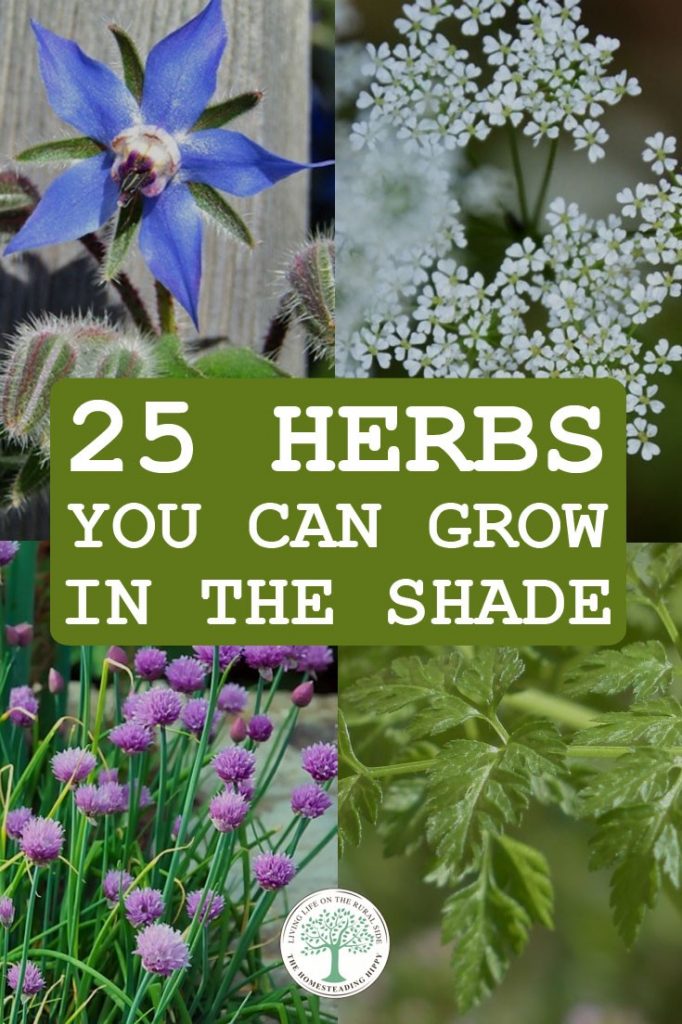

Amanda is a homesteader and a Jesus-loving, mother of 6 toddlers. She’s raising lots of fancy chickens and goats on her small homestead (among other things). Find out more about the team here.

Wow – that’s an amazing list that I will be sure to refer to in the future. I would encourage readers to be cautious where they plant mint – mine jumped from my herb bed to the nearby pond garden and ended up invading the water pump housing and clogging it.
One more herb that I recently found at my local garden center (virtually of course) is shade loving miner’s lettuce. It grew wild on my homestead and I look forward to this year’s crop perking up my salads.